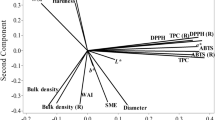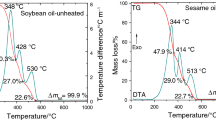Abstract
The objective of this work was to evaluate the effect of alkaline cooking on the oxidative stability of oil in corn flour. A central composite design was used to study the combined effect of lime concentration (%) and steep time (h) on peroxide value (PV); specific extinction coefficients at 232 and 270 nm (K232 and K270); and FTIR absorbance at 3009 cm−1, 3444 cm−1, and 3530 cm−1 in oils from corn flour obtained by alkaline cooking. The results indicate that lime concentration and steep time affected the PV, K232, and K270. A decrease of 2.56 % was observed in the IR absorption bands, corresponding to the polyunsaturated fatty acids. The FTIR spectra also showed absorption bands related to the secondary oil oxidation products.



Similar content being viewed by others
References
Sefa-Dedhe S, Cornelius B, Sakyi-Dawson E, Afoakwa EO (2003) Application of response surface methodology for studying the quality characteristics of cowpea-fortified nixtamalized maize. Innov Food Sci Emerg Technol 4:109–119
Serna-Saldívar SO, Amaya GCA, Herrera MP, Melesio CJL, Preciado ORE, Terron IAD, Vazquez CG (2008) Evaluation of the lime-cooking and tortilla making properties of quality protein maize hybrids grown in Mexico. Plant Foods Hum Nutr 63:119–125
Hernández-Uribe JP, Ramos-López G, Yee-Madeira H, Bello-Pérez LA (2010) Physicochemical, rheological and structural characteristics of starch in maize tortillas. Plant Foods Hum Nutr 65:152–157
Pappa MR, Palacios PP, Bressani R (2010) Effect of lime and wood ash on the nixtamalization of maize and tortilla chemical and nutritional characteristics. Plant Foods Hum Nutr 65:130–135
Arámbula-Villa G, Barrón-Ávila L, González-Hernández J, Moreno-Martínez E, Luna-Bárcenas G (2001) Efecto del tiempo de cocimiento y reposo del grano de maíz (Zea mayz L.) nixtamalizado, sobre las características fisicoquímicas, reológicas, estructurales y texturales del grano, masa y tortillas de maíz. Arch Latinoam Nutr 51(2):187–194
Choe E, Min DB (2006) Mechanisms and factors for edible oil oxidation. Comp Rev Food Sci Food Saf 5:169–186
Moros J, Roth M, Garrigues S, De la Guardia M (2009) Preliminary studies about thermal degradation of edible oils through attenuated total reflectance mid-infrared spectrometry. Food Chem 114:1529–1536
Guillen MD, Goicoechea E (2009) Oxidation of corn oil at room temperature: Primary and secondary oxidation products and determination of their concentration in the oil liquid matrix from 1H nuclear magnetic resonance data. Food Chem 116:183–192
Muik B, Lendl B, Molina-Díaz A, Ayora-Cañada MJ (2005) Direct monitoring of lipid oxidation in edible oils by Fourier transform Raman spectroscopy. Chem Phys Lipids 134:173–182
Guzmán E, Baeten V, Fernández-Pierna JA, García-Mesa JA (2011) Application of low-resolution Raman spectroscopy for the analysis of oxidized olive oil. Food Control 12:2036–2040
AOAC (1990) Official methods of analysis, 15th edn. Arlington, VA: Association of Official Analytical Chemists
Paz-Antolín I, Molero-Meneses M (2000) Aplicación de la espectrofotometría UV-visible al estudio de la estabilidad térmica de aceites vegetales comestibles. Grasas y Aceites 51:424–428. doi:10.3989/gya.2000.v51.i6
Winkler-Moser JK, Breyer L (2011) Composition and oxidative stability of crude oil extracts of corn germ and distillers grains. Ind Crop Prod 33:572–578
Martínez-Flores HE, Garnica-Romo MG, Romero VJU, Yahuaca JB (2006) Evaluating the quality of lipids during alkaline cooking of corn. J Food Lipids 13:177–185
Vidal-Quintanar RL, Love MH, Love JA, White PJ, Johnson LA (2003) Lipid-autoxidation-limited shelf-life of nixtamalizaed instant corn “masa”. J Food Lipids 10:153–163
Dantas MB, Albuquerque AR, Barros AK, Rodrigues Filho MG, Antoniosi Filho NR, Sinfrônio FSM, Rosenhaim R, Soledade LEB, Santos IMG, Souza AG (2011) Evaluation of the oxidative stability of corn biodiesel. Fuel 90:773–778
Papadimitriou V, Sotiroudis TG, Xenakis A, Sofikiti N, Stavyiannoudaki V, Chaniotakis NA (2006) Oxidative stability and radical scavenging activity of extra virgin olive oils: An electron paramagnetic resonance spectroscopy study. Anal Chim Acta 573–574:453–458
Guillén MD, Cabo N (2002) Fourier transform infrared spectra data versus peroxide and anisidine values to determine oxidative stability of edible oils. Food Chem 77:503–510
Yang H, Irudayaraj J, Paradkar M (2005) Discriminant analysis of edible oils and fats by FTIR, FT-NIR and FT-Raman spectroscopy. Food Chem 93:25–32
Conflict of Interest
The authors declare that they have no conflict of interest.
Author information
Authors and Affiliations
Corresponding author
Rights and permissions
About this article
Cite this article
Yahuaca-Juárez, B., Martínez-Flores, H.E., Huerta-Ruelas, J.A. et al. Oil Oxidation in Corn Flour from Grains Processed with Alkaline Cooking by Use of Peroxide Value, UV and FTIR. Plant Foods Hum Nutr 68, 65–71 (2013). https://doi.org/10.1007/s11130-012-0332-y
Published:
Issue Date:
DOI: https://doi.org/10.1007/s11130-012-0332-y




